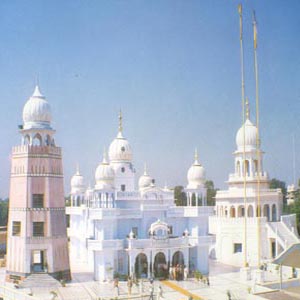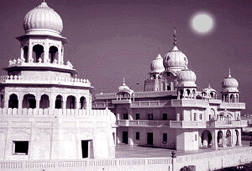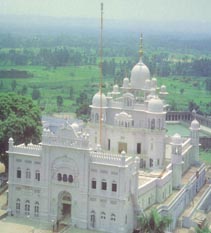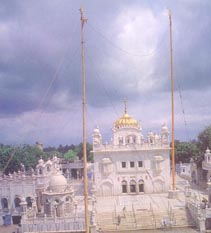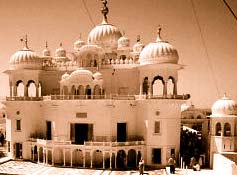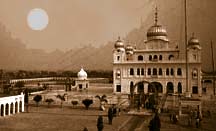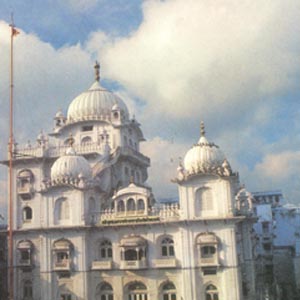|
The Most Sacred Sikh Shrines FIVE TAKHT'S OF KHALSA |
The meaning of the word 'Takht' is a four-legged wooden seat or imperial throne; that is to say the royal seat of a monarch to issue imperial fiats. Quite a large number of such 'Takhts' came into their own in the world. Time has eroded them. The manner in which the word 'Takht' has been used in Gurmat conception is unique. The 'Takht' is not subject decay. Rather it is eternal . It is free from the limitations of time and place. Such a conception of the 'Takht' has been invested with empiricism by the Ten Gurus. This has become a proven fact that 'Takht' is not a totalization of the activities of the individual/individuals. Rather, it evidences impartiality, independence and sovereignty of the ways of the Guru Panth. Gurdwara's are a common heritage of one and all Sikhs. The 'Takhts' relate to Gursikhs only. All the 'Five Takhts' are a fountainhead of inspiration and a center of enlightenment for the entire Khalsa Panth. Each 'Hukum' (commandment) is revered by a Gursikh. Bearing in mind the love and dedication of Gursikhs to the 'Takhts', the brief history regarding Takhts has been dedicated to them, this would mean that from a study of multi-coloured icons of the sacred 'Takhts' the reader may get a succinct historical information about them and feel inspired to visit them.
The Five Gurdwaras (Sikh Temples) known as the Five Takhts (Thrones) have a very special significance for the Sikh community. They are considered the seats of Sikh religious authority. Many important decisions concerning the religious and social life of the Sikh community were made here.
|
Shrines |
||
|
Akal Takht literally means Eternal Throne. It is part of the Golden Temple complex in Amritsar. The Akal Takht is situated on the other end of the causeway connected to the Harmandir Sahib. Its foundation was laid by Guru Hargobind. It was here that he was ceremonially installed as Guru in 1606. The building of the Akal Takht opposite the Golden Temple has a special meaning. While the Golden Temple stands for spiritual guidance the Akal Takht symbolizes the dispensing of justice and temporal activity. During the day the Guru Granth Sahib is kept in the Golden Temple, while at night it is kept in the Akal Takht. Traditionally all Sikh warriors sought blessings here before going to battle. During the 18th century while Sikhs were fighting a guerrilla war in the forests they used to gather at the Akal Takht on special occasions such as Baisakhi and Diwali. Here the community used to have general meetings and approve resolutions. The Akal Takht was the oldest of the Five Takhts, but it was destroyed by the Indian Army during its military invasion in 1984. It's reconstruction is almost complete. |
|
|
|
|
|
Takht Sri Damdama Sahib, Talwandi Sabo
|
Damdama Sahib is situated in the village of Talwandi Sabo near Bhatinda. This is where Guru Gobind Singh stayed for nearly a year and compiled the final edition of the Guru Granth Sahib known as the Damdama Sahib Bir in 1705. |
|
|
|
|
Keshgarh Sahib is situated at Anandpur. It is considered the birthplace of the Khalsa. The Khalsa order was founded here by Guru Gobind Singh in 1699. Some of the weapons of Guru Gobind Singh are displayed here. The most precious of these is the actual Khanda (double edged sword) used by Guru Gobind Singh to prepare the amrit (sweet water) used in the first Khalsa initiation ceremony. |
|
|
|
|
|
|
Hazur Sahib is on the banks of Godavari in Maharashtra. This is where Guru Gobind Singh left this world. The inner room of the temple is called Angitha Sahib and is built over the place where Guru Gobind Singh was cremated in 1708. |
|
|
|
|
Patna Sahib is situated in Patna, the capital of Bihar. It was here that Guru Gobind Singh was born in 1666 and spent his early years before moving to Anandpur. Besides being the birthplace of Guru Gobind Singh, Patna was also honoured by visits from Guru Nanak as well as Guru Tegh Bahadur ji. |
|

